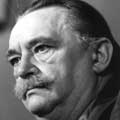After the tribute to soviet cinema and to the Zagreb school, Future Film Festival keep on pay attention to animation in East Europe. 2006 edition will dedicated a retrospective about the great master in puppet animation, Jiri Trnka and about the famous film school Famu in Praha. A selection of the best works realized in the last years will screened during the festival.
Movies by Jiri Trnka at Future Film Festival 2006:
Sen Noci Svatojánské (A Midsummer Night’s Dream)
1959, 35 mm, 73 min.
In 1959 Jiri Trnka came up with a work which represented the height of his puppet mastery, artistic imagination and directorial invention. A full-length, wide-screen puppet film, A Midsummer Night´s Dream is a wordless and magical version of Shakespeare´s play which captures both its fantastic, dream-like atmosphere and its profound human dimension with great genius.Ruka (The Hand)
1965, 35 mm, 18 min.
A love-puppet comedy developed to tell the story of a little man whose life and aspirations are constantly checked and impeded by the interfering symbolic HAND. Threatened by the Hand the little man cannot work on his own ideas.
Árie Prérie (The Song of the Prairie)
1949, 35 mm, 21 min.
An exciting adventure of a young girl, kidnapped from a stagecoach by gangsters and rescued after a terrible struggle by a galant cowboy. In 1949 Jiri Trnka made virtuoso parody of cheap westerns.
Pérák a SS (The Springer and SS-Men)
1946, 35 mm, 12 min.
A comic story of a legendary chimney-cleaner who, with the help of a spring from an old lounge-chair, became the terror of the SS troops occupying Prague during World War II.
Spalícek (The Czech Year)
1947, 35 mm, 75 min.
Sequence of folk costumes in six pictures: Carnival, Spring, Village Wake, Legend of St. Prokop, Wake, Betlehem.
Císaruv Slavík (The Emperor’s Nightingale)
1949, 35 mm.
Adaptation of the fairytale by H.Ch. Andersena creating parallel between thw world of a orient emperror and a child who is minutely cared by old aunts. The film draws its motives from china feudal tradition, but Trnka doesn´copied the decoration of old China. He created the emperror´s palace with its gardens in a dream fantasy of a child, from the point of a czech or european spectator. This film, radiating with kind humour and a dreamful magic, was for J. Trnka a new way of self-realisation in a puppet world.
Zvírátka a Petrovtí (The Animals and the Brigands)
1946, 35 mm, 9 min.
Three domestic animals, a goat, he-cat and cock go through the wood. They did´t like the food and treatment in the house so they decided to see the world.
Osudy Dobrého Vojáka Svejka III (Adventures Of The Good Soldier Svejk During The First World War III.)
Osudy Dobrého Vojáka Svejka II (Adventures Of The Good Soldier Svejk During The First World War II)
Osudy Dobrého Vojáka Svejka I (Adventures Of The Good Soldier Svejk During The First World War I)
1954 – 1955
Adventures of a good soldier during the first world war.
Dárek (The Present)
1951, 35 mm, 15 min.
Story about fisherman, his covetous wife and a golden fish.
Dva Mrazíci (Two Frosts)
1954, 35 mm, 12 min
Puppet story based on slovak themes.
DÁREK (THE PRESENT)
1946
Grotesque about problems of a author with a producer. Hero of the story is a man bying a present for his wife.
Bajaja (Prince Bajaja)
1950, 35 mm, 81 min.
n a village lives old man with his son Bajaja. Mother died and sorrow is still present. One day is Bajaja disturbed by a white horse who says with a human voice„I am your mother, if you want to save me come with me”, and so Bajaja says goodby to his father and leaves.
In a magical garden he receives magical gifts which should everytime bring him to his mother.
Bajaja comes to a castle, is admitted and becomes a companion to the primcesses. But the castle is spelled with cruel dragons as in the past the king promisd them his three daughters.
When there is turn of each of the princess, Bajaja with magic becomes a knight and saves them. And he is very keen of the third princess.
After the last dragon is killed there is a feast to celebrate and everybody expects the courageous knight to appear. But his mother hinders him saying that he will be lucky after all. The princess is discinsolate so her father proclaims a joust. There Bajaja appears and wins the princess hand. Also mother is freed from the spell.
Kybernetická Babicka (The Cybernetic Grandmother)
1962, 35 mm, 27 min.
A story of a girl lost in the overmechanized world.
Zasadil Dedek Repu (A Grandpa Planted A Beet)
1945, 35 mm.
SStory about a grandpa, grandma, their animals and a beet, which grew to an enormous size.
Certuv Mlyn (The Devil’s Mill )
1951, 35 mm21 min.
Story of an old veteran soldier who outsmarted the devil and returned the mill to its original purpose.
Vásen (Passion)
1961, 35 mm, 8 min.
Puppet. Satire about passionate motorists for high speed.
Archandel Gabriel a Paní Husa (Archangel Gabriel and Mistress Goose)
1964, 35 mm, 29 min.
Puppet. Story adaptation from Boccacio´s Decameron about a beautiful, but dull madam from medieval Venice.
Román s Basou (Story of a Contrabass)
1949, 35 mm, 14 min.
Based on the novel by Anton Pavloviechov about the musician Smyckov and the beautiful daughter of prince Bibulov.

